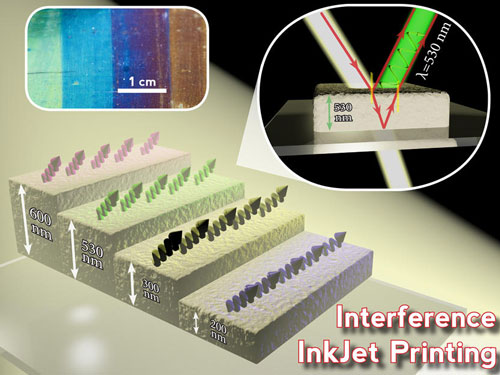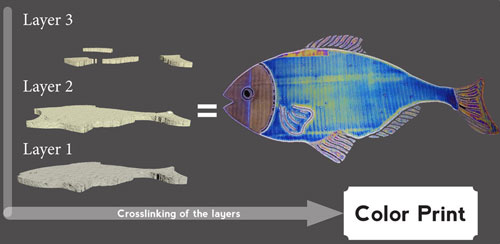| Posted: Feb 11, 2016 | |
Nanotechnology for next-generation inkjet color printing |
|
| (Nanowerk Spotlight) From dot matrix to 3D, color printing technology has come a long way in the past 40 years. All of these technologies have created colors by using dye inks, which not only limits the technological possibilities and color reproduction but also can be taxing on the environment, especially through the use of toxic heavy metals (see: Environmental Impact of Printing Inks; pdf). | |
| Nature is full of examples (e.g. insects, chameleons, fish, squid, butterflies) where colors are a result of light interference – so-called structural colors – and not pigments (read more in our previous Nanowerk Spotlight "Butterflies provide clues for replacing color pigments with photonic nanocrystals"). | |
| By replacing dye inks with optical nanostructures, researchers in Russia have now demonstrated the use of inkjet technology to create colored interference layers with high accuracy without the need for high-temperature fixing. The key to this technology is the ability to control the inkjet printing process to form nanostructures with high accuracy. | |
| The team from the Solution Chemistry of Advanced Materials and Technologies Lab at ITMO University in Saint Petersburg, led by Dr. Alexandr V. Vinogradov, has reported their findings in the January 25, 2016 online edition of ACS Nano ("Inkjet Color Printing by Interference Nanostructures"). | |
 |
|
| Lighting visualization of interference inkjet printing. (Reprinted with permission by American Chemical Society) | |
| Whereas conventional inkjet printing occurs in the microrange, this new work demonstrates that optical structures can be printed with much greater accuracy, which in particular opens the prospects in developing controlled interference printing of interference color images. | |
| "In our paper, we report the first application of nanocrystalline sol-gel systems for the production of controlled interference in thin films using colorless ink based on titanium dioxide colloids," Vinogradov tells Nanowerk. "Adjustable multilayer printing of highly refractive layers, by controlling the film thickness, allowed us to create optical nanostructures on the polymer surface. These nanostructures provide the light interference, which results in visual coloration." | |
| He points out that the apparent advantage of interference is natural color reproduction, because the entire sunlight spectrum is used for imaging, including the maximum possible number of colors and shades distinguished by the human eye. | |
| The researchers note, however, that saturation of color responsible for the contrast of the image will largely depend on the magnitude of the difference between the refractive indices of the applied layer and used substrate. | |
 |
|
| Scheme of layer-by-layer inkjet printing to produce a full color image. Strips and discoloration caused in a single layer depend on inkjet characteristics into nonporous surfaces associated with drying and subsequent application of a small deviation from the place printing. (Reprinted with permission by American Chemical Society) | |
| "The presence of a highly refractive layer enclosed between the air and polymeric substrate, both with low refractive index, allows us to extract the light reflection complementary in wavelength to the thickness of this layer," explains Vinogradov. "Given the number of colors in the visible spectrum, the number of shades of the structures applied by an inkjet printer is virtually unlimited." | |
| This work currently is at the proof-of-principle stage. The team hasn't managed yet to obtain clear red colors with their interference approach and the color prints produced by this method retain the intended coloration only within a narrow range of viewing angles. However, they are confident that by manipulating the phase transition from liquid to solid during the sol-gel process of the inks will provide a solution for these issues. | |
 By
Michael
Berger
– Michael is author of three books by the Royal Society of Chemistry:
Nano-Society: Pushing the Boundaries of Technology,
Nanotechnology: The Future is Tiny, and
Nanoengineering: The Skills and Tools Making Technology Invisible
Copyright ©
Nanowerk LLC
By
Michael
Berger
– Michael is author of three books by the Royal Society of Chemistry:
Nano-Society: Pushing the Boundaries of Technology,
Nanotechnology: The Future is Tiny, and
Nanoengineering: The Skills and Tools Making Technology Invisible
Copyright ©
Nanowerk LLC
|
|
|
Become a Spotlight guest author! Join our large and growing group of guest contributors. Have you just published a scientific paper or have other exciting developments to share with the nanotechnology community? Here is how to publish on nanowerk.com. |
|
